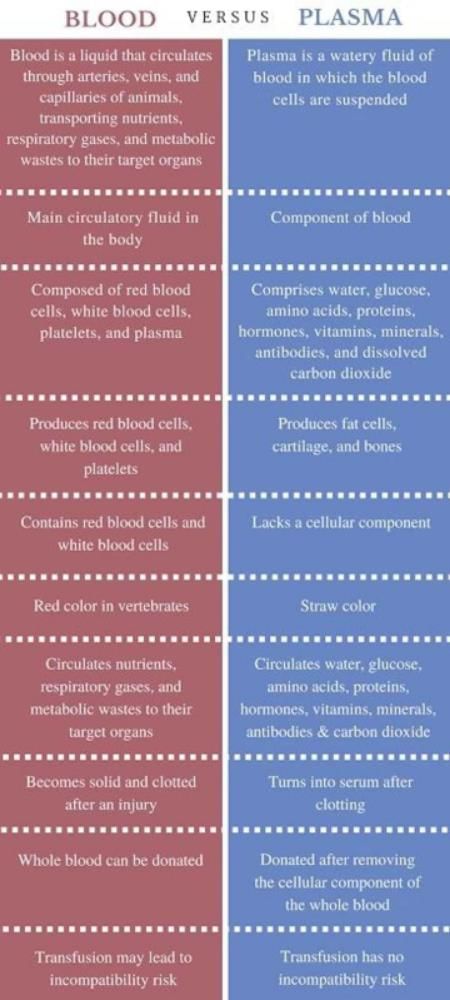NEET Exam > NEET Questions > Difference between blood and plasma ?
Start Learning for Free
Difference between blood and plasma ?
Community Answer
Difference between blood and plasma ?
Blood vs. Plasma
Blood and plasma are both crucial components of the circulatory system, but they serve different functions and have distinct compositions.
Composition
- Blood is a complex mixture of cells, proteins, and other substances suspended in a liquid called plasma.
- Plasma is the liquid component of blood that makes up about 55% of its total volume. It is a pale yellow fluid composed mostly of water, electrolytes, hormones, and proteins.
Functions
- Blood plays a vital role in transporting oxygen, nutrients, hormones, and waste products throughout the body. It also helps regulate body temperature and maintain pH balance.
- Plasma serves as a medium for carrying cells and proteins throughout the body. It is essential for maintaining blood pressure and proper circulation.
Components
- Blood consists of red blood cells, white blood cells, and platelets, which are suspended in plasma.
- Plasma contains proteins such as albumin, globulins, and fibrinogen, as well as electrolytes like sodium, potassium, and calcium.
Importance
- Blood is essential for delivering oxygen to tissues, fighting infections, and clotting to prevent excessive bleeding.
- Plasma is crucial for maintaining blood volume, transporting nutrients, and supporting immune function.
In conclusion, while blood and plasma are closely related, they are distinct components of the circulatory system with different compositions and functions. Blood relies on plasma to transport essential components throughout the body, making both crucial for overall health and well-being.
Blood and plasma are both crucial components of the circulatory system, but they serve different functions and have distinct compositions.
Composition
- Blood is a complex mixture of cells, proteins, and other substances suspended in a liquid called plasma.
- Plasma is the liquid component of blood that makes up about 55% of its total volume. It is a pale yellow fluid composed mostly of water, electrolytes, hormones, and proteins.
Functions
- Blood plays a vital role in transporting oxygen, nutrients, hormones, and waste products throughout the body. It also helps regulate body temperature and maintain pH balance.
- Plasma serves as a medium for carrying cells and proteins throughout the body. It is essential for maintaining blood pressure and proper circulation.
Components
- Blood consists of red blood cells, white blood cells, and platelets, which are suspended in plasma.
- Plasma contains proteins such as albumin, globulins, and fibrinogen, as well as electrolytes like sodium, potassium, and calcium.
Importance
- Blood is essential for delivering oxygen to tissues, fighting infections, and clotting to prevent excessive bleeding.
- Plasma is crucial for maintaining blood volume, transporting nutrients, and supporting immune function.
In conclusion, while blood and plasma are closely related, they are distinct components of the circulatory system with different compositions and functions. Blood relies on plasma to transport essential components throughout the body, making both crucial for overall health and well-being.

|
Explore Courses for NEET exam
|

|
Similar NEET Doubts
Difference between blood and plasma ?
Question Description
Difference between blood and plasma ? for NEET 2025 is part of NEET preparation. The Question and answers have been prepared according to the NEET exam syllabus. Information about Difference between blood and plasma ? covers all topics & solutions for NEET 2025 Exam. Find important definitions, questions, meanings, examples, exercises and tests below for Difference between blood and plasma ?.
Difference between blood and plasma ? for NEET 2025 is part of NEET preparation. The Question and answers have been prepared according to the NEET exam syllabus. Information about Difference between blood and plasma ? covers all topics & solutions for NEET 2025 Exam. Find important definitions, questions, meanings, examples, exercises and tests below for Difference between blood and plasma ?.
Solutions for Difference between blood and plasma ? in English & in Hindi are available as part of our courses for NEET.
Download more important topics, notes, lectures and mock test series for NEET Exam by signing up for free.
Here you can find the meaning of Difference between blood and plasma ? defined & explained in the simplest way possible. Besides giving the explanation of
Difference between blood and plasma ?, a detailed solution for Difference between blood and plasma ? has been provided alongside types of Difference between blood and plasma ? theory, EduRev gives you an
ample number of questions to practice Difference between blood and plasma ? tests, examples and also practice NEET tests.

|
Explore Courses for NEET exam
|

|
Signup for Free!
Signup to see your scores go up within 7 days! Learn & Practice with 1000+ FREE Notes, Videos & Tests.



























